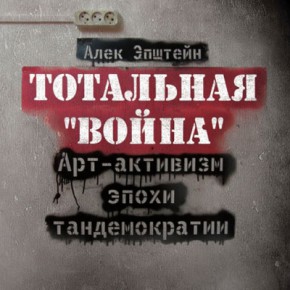

Alek Epstein's book 'Total 'Voina'(War): Art Activism in the Era of Tandemocracy' gives one a particularly fresh insight into the movement which led up to the recent Pussy Riot scandal. Nadezhda Tolokonnikova - one of the three alleged Pussy Riot members- played a significant part in the 'Voina' art group. Epstein- an Israeli journalist and scholar who has previously specialised in the Israel-Palestine question- has given an insiders account of this group and the development of its many actions. Perhaps most famous was the painting of the huge phallus outside the FSB headquarters in St Petersburg but there were many others which achieved greater or lesser public resonance. Epstein explains the development of the group, the schisms, the ideology and the origins in earlier art activist and artistic trends as well as the movement from art to political activism which has been especially true of the Moscow wing of the group in recent times. Epstein is well acquainted with the members of the 'Voina' group and herein lies his especial attention to the inner workings of the group. He also pays a lot of attention to the role of Aleksei Plutser Sarno who, in many ways, controlled the way that the group was received as well as, according to Epstein, influencing the process of exclusion of certain early members of the group. The book is, perhaps, the first full-scale attempt to describe this art activism in contemporary Russia and the group 'Voina' and it is to be hoped that a translation could be in the offing. While it doesn't give too much detail on the genesis and context of the group in terms of contemporary Russian art movements it does mention names like Alexander Brener, Monastirsky and others such as Edward Limonov who are in some way predecessors. The availability of material on the group in English is detailed in Plutser-Sarno's blog on Voina
http://plucer.livejournal.com/537393.html and while awaiting a more detailed, scholarly and dispassionate account of Voina, this book by Alek Epstein is a reasonable beginning filling in many details of the history of one of Russia's most radical art group.
 Having missed the photoexhibition at the Moscow Photo-biennale of the photographs of Sokurov's 'Russian Art', I made sure that the Mishukov exhibition on Zviagintsev's 'Elena' was something that wouldn't be missed. The Mishukov photos are something more than a mere record of the shooting of the film 'Elena' and have an artistic power to them in their own right. Mishukov managed to take his photographs at those moments of rest and preparation but some of the photographs of the leading characters capture some simply splendid moments and they give themselves to new readings that may or may not have been in the film. One of the really fascinating exhibitions of the Moscow Photobiennale.
Having missed the photoexhibition at the Moscow Photo-biennale of the photographs of Sokurov's 'Russian Art', I made sure that the Mishukov exhibition on Zviagintsev's 'Elena' was something that wouldn't be missed. The Mishukov photos are something more than a mere record of the shooting of the film 'Elena' and have an artistic power to them in their own right. Mishukov managed to take his photographs at those moments of rest and preparation but some of the photographs of the leading characters capture some simply splendid moments and they give themselves to new readings that may or may not have been in the film. One of the really fascinating exhibitions of the Moscow Photobiennale.


















 Harry Gruyaert Moscow 1989-2009.
Harry Gruyaert Moscow 1989-2009. William Klein New York 1955
William Klein New York 1955
 Los Angeles Criminal Archive Photo
Los Angeles Criminal Archive Photo Sergey Shestakov: Journey into the Future :Stop #2 Gudym
Sergey Shestakov: Journey into the Future :Stop #2 Gudym
 Chris Marker's The Great Premakes film poster series.
Chris Marker's The Great Premakes film poster series. 




 One of the most interesting exhibitions being held at the moment is the one devoted to the 75th anniversary of the 'museification' of Mayakovsky. Although not in the same premises for 75 years it was in that fatal year of 1937 that a Mayakovsky museum and library were to be opened. While the Mayakovsky Museum itself is not hosting any special exhibition, the Proun Gallery at the Vinzavod Complex (a Gallery noted for its attention to exhibiting the Soviet avant-garde) is showing the graphic art works held by the Mayakovsky Museum (but rarely publicly exhibited). The graphic works of El Lisitsky, Rodchenko, Sen'kin and Klutsis are being put on display here until the 8th May. Quite a treat for anyone interested in the photomontages of these great artists.
One of the most interesting exhibitions being held at the moment is the one devoted to the 75th anniversary of the 'museification' of Mayakovsky. Although not in the same premises for 75 years it was in that fatal year of 1937 that a Mayakovsky museum and library were to be opened. While the Mayakovsky Museum itself is not hosting any special exhibition, the Proun Gallery at the Vinzavod Complex (a Gallery noted for its attention to exhibiting the Soviet avant-garde) is showing the graphic art works held by the Mayakovsky Museum (but rarely publicly exhibited). The graphic works of El Lisitsky, Rodchenko, Sen'kin and Klutsis are being put on display here until the 8th May. Quite a treat for anyone interested in the photomontages of these great artists. 



















